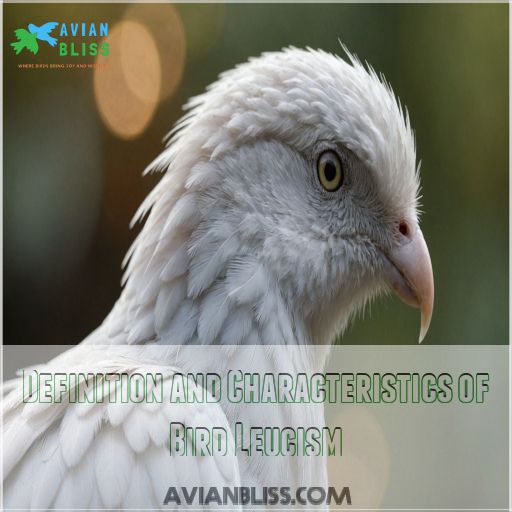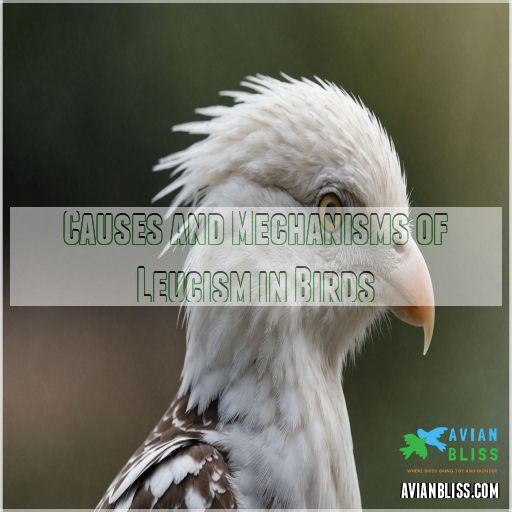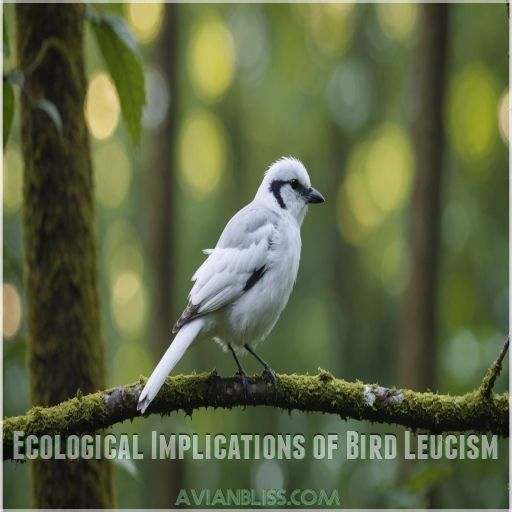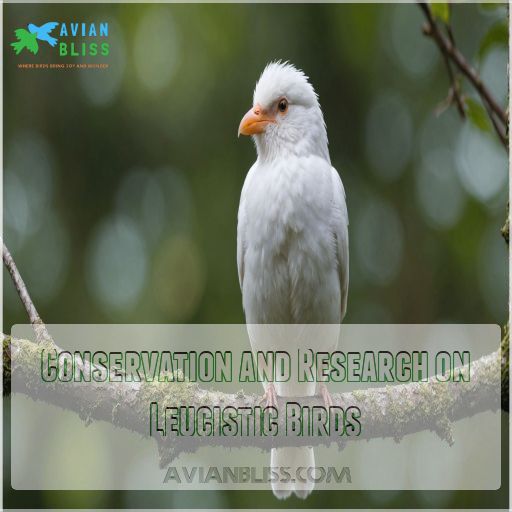This site is supported by our readers. We may earn a commission, at no cost to you, if you purchase through links.
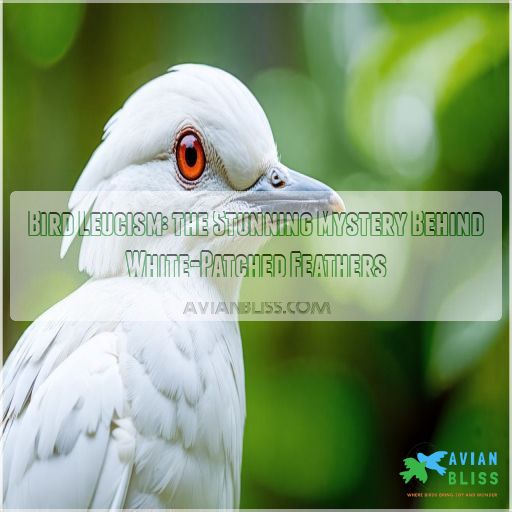
It’s a rare phenomenon, affecting roughly 1 in 30,000 birds. Leucistic birds face unique challenges, from increased predation risk to thermoregulation issues.
Their unusual appearance can even impact mating success – talk about a tough dating scene! While leucism can occur in any species, some birds wear it better than others.
The genetic mechanisms behind this condition are complex, involving mutations in pigment-producing cells. Unraveling the mysteries of leucism could shed light on broader aspects of avian biology and evolution.
Table Of Contents
- Key Takeaways
- Definition and Characteristics of Bird Leucism
- Causes and Mechanisms of Leucism in Birds
- Identifying Leucistic Birds in the Wild
- Ecological Implications of Bird Leucism
- Conservation and Research on Leucistic Birds
- Frequently Asked Questions (FAQs)
- What is bird leucism?
- What causes leucism in birds?
- How do you know if a bird has leucism?
- What is an example of a leucistic bird?
- How rare is leucism in birds?
- What does it mean when a bird is leucistic?
- What is the difference between albino and leucistic birds?
- Does leucism exist in humans?
- Can leucistic birds have normal-colored offspring?
- How does leucism affect a birds lifespan?
- Are some bird species more prone to leucism?
- Can leucism develop over time in adult birds?
- Do leucistic birds require special care in captivity?
- Conclusion
Key Takeaways
- You’ll find that bird leucism is a rare genetic condition that causes partial or complete loss of pigmentation in feathers, affecting about 1 in 30,000 birds. It’s like nature’s paintbrush got a bit sloppy, leaving these feathered friends with eye-catching white patches or pale plumage.
- Don’t confuse leucism with albinism—leucistic birds retain their normal eye color, unlike their red-eyed albino cousins. It’s a bit like they’ve got a stylish new outfit but kept their signature sunglasses on.
- These unique birds face some tough challenges, from increased predation risk to thermoregulation issues. Imagine trying to blend in at a bird party when you’re sporting a flashy white tuxedo—it’s not easy being the odd bird out.
- You can play detective and help researchers by reporting leucistic bird sightings through citizen science initiatives. It’s like being part of a real-life bird treasure hunt, where your observations could unlock secrets about avian genetics and evolution.
Definition and Characteristics of Bird Leucism
You’ve likely spotted a bird with unusual white patches and wondered about its cause.
Bird leucism, a genetic condition affecting pigment-producing cells, resulting in white feathers or pale plumage, is responsible for the white stripes seen on the wings of some black birds. the white stripes on the wings.
This condition can range from partial to complete coverage.
Genetic Basis of Leucism
One might wonder what causes those eye-catching white patches on birds.
Leucism, a genetic condition, results from mutations affecting pigment cell development or function . You’ll find it’s often inherited in specific patterns, with genes like the melanocortin 1 receptor playing a key role.
Unlike progressive greying, leucism appears in juvenile plumage and remains static throughout a bird’s life.
This fascinating quirk of nature offers a window into avian genetics and evolution.
Partial Vs. Complete Leucism
Leucism in birds isn’t an all-or-nothing affair. You’ll find two main types: partial and complete leucism. While the genetic basis remains the same, the visual results can be strikingly different. Leucistic birds are more common than albino birds, but still considered rare sightings, with only about one out of every 30,000 robins exhibiting leucism, caused by a genetic mutation Leucistic robins characteristics.
Imagine you’re birdwatching in Doñana National Park. You might spot:
- A completely pale bird, looking like a ghost of its species
- A bird with irregular white patches, as if splattered with paint
- A bird’s unique appearance can be attributed to various natural phenomena, including its avian crests, or feathery mohawks, which serve multiple functions in bird behavior. A normal-looking bird with just a few white feathers
These abnormal plumage patterns can impact camouflage and mating behavior, potentially affecting survival rates.
Differences Between Leucism and Albinism
While both conditions affect feather pigment, you’ll find key differences between leucism and albinism in birds, which can be seen in the characteristics of albino parrot traitsalbino parrot characteristics.
Leucism results in partial pigment loss, causing white patches or splotches, while albinism leads to complete absence of melanin (Source).
You can spot the difference in their eyes: leucistic birds maintain normal eye color, but albino birds have pale, pink, or red eyes.
These genetic variations impact survival rates and breeding implications differently.
Prevalence of Leucism in Bird Populations
Now that you’ve seen how leucism differs from albinism, you might wonder: how common is this feathery phenomenon?
Studies show leucism is quite rare, occurring in roughly 1 out of every 30,000 birds. It’s like finding a four-leaf clover in a field of feathers!
It’s also worth noting that some species are more prone to leucism than others. Blackbirds, house sparrows, and crows seem to be the trend-setters in this white-speckled fashion.
Impact on Feather Structure and Strength
In the world of bird biology, leucism casts a fascinating shadow on feather structure and strength.
Their altered feathers can impact:
- Flight efficiency, as if they’re piloting a slightly off-balance plane
- Thermoregulation, like wearing a patchy insulation jacket
- Bacterial resistance, leaving them more vulnerable to nature’s tiny invaders
Leucistic birds may experience increased feather wear and parasite susceptibility. Their feathers, though striking, often lack the robust structure of their fully pigmented counterparts, potentially affecting their survival in the wild.
Causes and Mechanisms of Leucism in Birds
You’ll find that leucism in birds stems from a complex interplay of genetic mutations and developmental processes affecting melanin production.
These factors, combined with environmental influences, determine how leucistic traits manifest in a bird’s plumage, creating the striking white patches that catch your eye in the wild.
Genetic Mutations Affecting Melanin Production
Melanin in stems from genetic mutations, such as those affecting the SLC45A2 and TYRP1b. These mutations hinder melanin production, leading to leucism—a condition distinct from albinism. Unlike albinism, leucism allows normal eye pigmentation. Understanding these genetic factors demonstrates how phenotype variation occurs, driving pigmentation evolution and aiding genetic testing.
TYRP1b
SLC45A2
Environmental Factors Influencing Leucism Expression
Genetic factors play a major role, but the environment also shapes leucism expression.
Consider the following influences:
- Habitat: Changing landscapes can trigger pigmentation changes.
- Stress: Early life stress impacts feather coloration.
- Pollution: Contaminants might alter melanin production.
- Diet: Nutritional deficiencies disrupt pigment synthesis.
Understanding these elements helps unravel leucism’s mystery in birds.
Developmental Processes Leading to Leucistic Traits
Birds develop leucistic traits through various fascinating processes.
You might imagine pigment cell distribution as an artist who skips certain strokes, leading to white patches.
Cellular development and timing play important roles too; if the developmental window closes early, pigments can’t reach their destination.
Additionally, environmental triggers like pollution can disrupt this delicate dance, influencing leucism’s appearance.
Inheritance Patterns of Leucistic Genes
Ever wonder how leucistic genes pass through bird generations?
These genes, often recessive, require a copy from each parent to express leucism.
This inheritance pattern may lead to phenotype variability, as white patches can skip generations.
Gene expression, influenced by mutation frequency, greatly impacts leucism genetics and breeding patterns among avian populations.
Role of Pigment Cell Distribution in Leucism
Unraveling the role of pigment cell distribution in bird leucism reveals how it shapes those stunning white patches.
In leucism, melanocytes—the cells responsible for melanin—aren’t correctly distributed during feather development, leading to patchy leucism.
Think of them as painters forgetting parts of the canvas, resulting in unique, eye-catching patterns that draw a little extra attention from the avian fashion police.
Identifying Leucistic Birds in the Wild
When you’re out in the wild, spotting a leucistic bird requires a keen eye for their unique white patches, which stand out against normally pigmented plumage, a trait that can be seen in many birds with black and white heads.
You need to recognize common leucistic patterns, like irregularly distributed white feathers, while distinguishing these birds from those with similar plumage variations such as albinism or progressive greying.
Visual Cues for Recognizing Leucistic Individuals
Keen observers can spot leucistic birds by their eye color, feather patterns, body markings, wing coloration, and bill hue. These unique visual cues set them apart from their fully-pigmented counterparts.
Look for:
- Pale or mottled eyes
- Irregular white patches on feathers
- Lighter or mismatched body parts
- Washed-out wing shades
- Pale or discolored bills
Identifying leucistic birds requires a keen eye, but the payoff is seeing nature’s stunning diversity. (Source)
Common Leucistic Patterns Across Bird Species
Spotting leucistic birds requires a keen eye for distinctive feather distribution.
You’ll find common leucistic patterns like white wing patches and head markings in species such as the Red-winged Blackbird and House Finch.
These patterns are often bilaterally symmetrical, resulting from developmental processes that affect melanoblast migration, leaving certain body areas without coloration.
Distinguishing Leucism From Other Plumage Abnormalities
As you explore bird plumage, you’ll notice leucism stands out, differing from albinism, greying, and even melanism (Source).
Leucistic birds sport pale feathers but keep their natural eye color, unlike the red eyes in albinism.
Distinguishing leucism also involves ruling out dilution and xanthochroism, which involve unique pigment changes.
Keep this in mind for accurate identification.
Seasonal Variations in Leucistic Appearances
You’ve just distinguished leucism from other abnormalities, so how about spotting seasonal variations?
Leucistic birds display diverse patterns due to molting patterns during the breeding season.
These variations, influenced by temperature and environmental changes, can affect camouflage and increase predation risk.
By observing these stunning shifts, you might better appreciate the intricate dance of nature’s palette .
Tools and Techniques for Documenting Leucistic Birds
Understanding seasonal changes, you can better document leucistic birds in the wild using tools like photography, field guides, and citizen science apps.
Follow these steps:
- Capture unique feather patterns with photography.
- Use field guides for accurate identification.
- Engage in citizen science by recording data.
- Create checklists to track sightings and share findings with others.
Ecological Implications of Bird Leucism
When you encounter a leucistic bird, its distinct white patches aren’t just intriguing; they’re ecologically significant too.
These markings can affect survival by increasing predation risk and complicating social interactions, ultimately influencing the bird’s adaptation and mating success.
Predation Risks for Leucistic Individuals
Spotting white patches amidst the greenery can be a dead giveaway.
Leucistic birds, with reduced pigmentation, often lack the camouflage that normally helps them blend into their surroundings, making them more visible to predators.
This increased visibility can lead to higher predation risks, affecting their survival rates and flight ability as they struggle to escape sharp-eyed hunters.
Effects on Mating Success and Reproduction
Leucistic birds may struggle to find mates, as plumage can make them unrecognizable to potential partners, and this challenge is especially pronounced in species that rely heavily on visual cues for mate selection, such as Bald Eagles’ spectacular courtship rituals.
In such cases, leucistic birds may face reduced mating success and reproductive fitness, which can have significant ecological implications. This can impact their breeding success and reproductive fitness.
However, some bird species, such as the Laysan Albatross, with long-term monogamous bonds may be less affected by leucism in mate recognition. More research is needed to fully understand the effects of leucism on avian mating and reproduction.
Ma, X., Jiang, H., Dong, L., & Zhang, Z. (2021). Partial leucism in an Oriental reed warbler (Acrocephalus orientalis) population. Avian Research, 12 (1), 1-6.
Thermoregulatory Challenges Faced by Leucistic Birds
While leucism can affect a bird’s mating success, it also brings thermoregulatory challenges.
You might think about insulation loss, heat stress, and the energy demands this condition creates.
White feathers reduce a bird’s ability to regulate body temperature efficiently, resulting in increased plumage wear and energy use to stay warm or cool.
It’s a bit like wearing a stylish, but impractical, outfit to deal with the challenges of thermoregulatory difficulties.
Impact on Species Recognition and Social Interactions
Feathers of a different color can ruffle more than just plumage. Leucistic birds face unique challenges in the avian social scene.
You’ll find these white-patched individuals dealing with a complex world of mate choice, social status, and flock dynamics. Their unusual appearance can often be a result of disruptions in visual displays, which are crucial for mating rituals and territorial defense, and can throw a wrench in the works of bird communication signals and territorial behavior.
- Potential mates might give them the cold shoulder
- Flock members could view them as outsiders
- Rivals may misinterpret their territorial displays
- Parents might struggle to recognize their own chicks
Adaptation and Survival Rates of Leucistic Populations
You might think leucistic birds are sitting ducks, but nature’s full of surprises.
These white-patched wonders face unique challenges, from standing out like a sore thumb to predators to potentially getting the cold shoulder from potential mates.
However, some populations show evidence of selection for leucism, hinting at possible adaptive advantages .
It’s a delicate balancing act between camouflage, predator pressure, and mating success, influencing their overall survival rates in the wild, a true test of survival rates.
Conservation and Research on Leucistic Birds
You’ll find conservation efforts for leucistic birds fascinating, as researchers monitor wild populations and conduct genetic studies to unravel the mysteries behind this stunning plumage variation.
Citizen science initiatives play a key role, allowing you to contribute valuable data by reporting leucistic bird sightings, which aids in understanding the prevalence and impact of this condition across different species.
Monitoring Leucism Prevalence in Wild Populations
Tracking leucistic birds in the wild is like a treasure hunt for scientists and bird enthusiasts alike. By keeping an eye out for these unique individuals, you’re contributing to valuable research.
Here’s how you can join the effort:
- Snap photos of unusual white-patched birds
- Note the location and date of your sighting
- Submit your observations to citizen science programs
- Learn to distinguish leucism from albinism
- Share your findings with local birding communities
This long-term monitoring helps uncover leucism trends and their impact on bird populations.
Genetic Studies on Leucistic Bird Lineages
Genetic studies on leucistic bird lineages offer fascinating insights into avian evolution.
Scientists map leucistic genes, revealing intricate patterns of lineage diversity.
You’ll be amazed to learn that leucism might offer an evolutionary advantage in some species, like domestic birds.
Population genetics research shows varying frequencies of leucism among different bird populations, shedding light on their adaptability.
These findings have significant conservation implications, helping us understand and protect our feathered friends better.
Captive Breeding Programs for Leucistic Individuals
Feathered friends with unique genes find sanctuary in captive breeding programs. These initiatives aim to preserve genetic diversity while studying leucistic traits.
You’ll discover that ethical considerations shape breeding strategies, balancing conservation value with animal welfare.
Researchers use these programs to unravel the mysteries of leucism, potentially aiding reintroduction efforts. It’s like piecing together a living puzzle, where each white-patched bird holds a clue to nature’s bird coloration secrets.
Citizen Science Initiatives for Reporting Leucistic Sightings
You’ve got a unique opportunity to contribute to bird research right from your backyard! Citizen science initiatives are revolutionizing leucism reporting. By participating, you’ll help scientists uncover species trends and geographic patterns.
Here’s how you can get involved:
- Download bird identification apps
- Join online birding communities
- Submit photos of leucistic birds to databases
- Attend local birdwatching events
Your observations could make a real difference in conservation efforts. So grab your binoculars and start spotting those white-patched wonders!
Ethical Considerations in Leucistic Bird Research
While citizen science initiatives spark curiosity, researchers must tread carefully when studying leucistic birds.
You’ll want to keep bird welfare in mind first, balancing the pursuit of knowledge with the potential impact on these unique individuals.
Captive breeding programs require strict ethical oversight to prevent exploitation.
When collecting data, respect the birds’ privacy and natural habitats.
Remember, public outreach is key – share your findings responsibly to foster understanding without compromising the safety of these feathered wonders.
Frequently Asked Questions (FAQs)
What is bird leucism?
Bird leucism is a genetic mutation causing partial or total reduction of color in plumage.
It’s like nature’s paintbrush got a bit sloppy, leaving white patches or pale feathers.
Notably, birds’ eyes and bare parts retain normal coloration.
What causes leucism in birds?
Oh, those pesky pigment cells, playing hide-and-seek in feathers.
Leucism stems from defective pigment cell development. You’ll find birds sporting white patches or paler plumage due to this genetic quirk.
It’s inherited, but don’t worry—their eyes stay dark, unlike albinos.
How do you know if a bird has leucism?
You’ll spot leucism in birds by their unusual white patches or pale plumage.
Look for normal-colored eyes, bill, and bare parts. It’s like they’ve been partially bleached!
Compare with nearby birds to confirm the odd coloration.
What is an example of a leucistic bird?
Like a snowy surprise in a colorful aviary, a leucistic Black Phoebe stands out.
Normally jet-black, this flycatcher’s rare genetic mutation causes white patches or an all-white appearance.
You’ll spot it behaving typically, catching insects mid-air, despite its unusual plumage.
How rare is leucism in birds?
Leucism in birds is remarkably rare.
Only about 1 in 30,000 birds exhibit this condition.
It’s like finding a needle in a haystack! You’re more likely to spot a four-leaf clover than a leucistic bird.
What does it mean when a bird is leucistic?
When a bird’s plumage lacks its usual colors, it’s leucistic.
This genetic mutation reduces pigment deposition in feathers, resulting in white patches or a washed-out appearance.
Unlike albinism, leucistic birds retain normal eye, bill, and leg coloration.
What is the difference between albino and leucistic birds?
You’ll spot the difference in their eyes. Albino birds have pink or red eyes due to a complete lack of melanin, while leucistic birds maintain dark eyes despite patchy or all-white feathers.
Albinism affects the entire body; leucism’s partial.
Does leucism exist in humans?
Unlike a chameleon’s color-changing ability, leucism doesn’t exist in humans.
This genetic condition, causing partial pigment loss, is found only in animals.
You’ll notice it in creatures with white patches but normal eye color.
Can leucistic birds have normal-colored offspring?
Leucistic birds can indeed produce normal-colored offspring.
The genes responsible for leucism are typically recessive, allowing normal-plumaged adults to carry them without showing signs.
When these carriers mate, their chicks may exhibit typical coloration.
How does leucism affect a birds lifespan?
Imagine a bird’s life as a canvas: leucism paints white streaks, yet doesn’t necessarily shorten the masterpiece.
Research shows leucistic nightjars live as long as their normal-colored peers, defying expectations.
Your feathered friends with this condition can thrive, adapting to their unique plumage.
Are some bird species more prone to leucism?
Some bird species are indeed more prone to leucism. Blackbirds, house sparrows, jackdaws, and carrion crows show higher frequencies of abnormal plumages.
You’ll spot these eye-catching oddities more often in urban areas, where they’re easier to observe.
Keep your eyes peeled, and watch out for leucism.
Can leucism develop over time in adult birds?
While juvenile birds rarely show white feathers, adults can surprise you.
As they age, some birds develop leucism, a condition where feathers lose pigment.
This ‘progressive greying’ phenomenon increases with age, especially in certain species like red-necked nightjars.
Do leucistic birds require special care in captivity?
Leucistic birds don’t typically need special care in captivity.
They require a balanced diet rich in protein and carotenoids to support their health.
They need protection from sunburn and predators due to their conspicuous coloration .
Conclusion
As you venture into the wild, keep your eyes peeled for these feathered anomalies.
Bird leucism, with its striking white patches, offers a window into nature’s genetic surprises. While these unique birds face challenges, they’re living proof of avian diversity.
Next time you spot a peculiarly pale plumage, you’ll know there’s more than meets the eye.
The mystery of bird leucism continues to captivate researchers and birdwatchers alike, reminding us that even in familiar species, nature always has something extraordinary to reveal.

